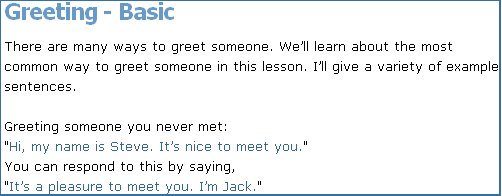Llengua anglesa a secundària. Competència digital
- guia
- Mòdul 0
- Mòdul 1
- Mòdul 2
- Mòdul 3
- Mòdul 4
- Mòdul 5
- Mòdul 6
- projecte
- índex
Speaking practice
Although speaking is something in which a minimum of two people are involved, it is possible to hear real conversations and do some speaking practice over the Internet. In this practice we will see some sites which solely aim to focus on speaking. They provide real conversations in real English - not the one you find in textbooks. They teach everyday words and idioms, pronunciation and intonation by listening to a model and repeating and even recording yourself.
Practice it!
The aim of this site is to help students gain fluency when speaking English, to learn to speak without thinking about the rules and logic. The idea behind the project is that by listening to model conversations and repeating them, the conversations become part of you, and then they come out naturally. The lessons are varied, and classified under Regular English, Travel English, Useful phrases and idioms, Interview English and Business English. If you register - for free -, you may participate in the different message boards and submit your recordings.
The sample sentences are written in blue. When you click on them, the audio file starts to download.
The audio is not ready.
The Play button is darkened. You may now play and listen.
Play and repeat them as many times as you want. Make sure you pronounce all the words correctly and that you use the right intonation.
- Every few lessons there is an interactive practice. Go back and click on lesson 4. All the previous sentences are found in a complete conversation. Click on f
 to hear the dialogue, or
to hear the dialogue, or  to hear the individual parts. Listen several times. When you feel comfortable with it, play and repeat.
to hear the individual parts. Listen several times. When you feel comfortable with it, play and repeat.
- This section explains all that must be taken into account when learning to speak a language. If you would like to be evaluated, you may record your performance and send it in for feedback. Just follow the step by step instructions.
Activity framework
- Methodology: Students sit in pairs at the computer. They listen to the dialogues and practice saying them. In another window, they may create a similar dialogue and act it out after rehearsing for some time. Give them a worksheet with the instructions. If you have a self-access in your classroom, this website may be an excellent resource for the listening/speaking corner.
- Resources: It is advisable that the students use headphones instead of the computer’s loudspeakers, to avoid excess noise and interferences. Even if you don’t send in your sound files, you may want to have your students record their voices so that they can learn from hearing themselves. In that case, you will need one (or several) microphones.
Additional info
 Focus English students may listen to conversations on a variety of topics and practice responding. In the section English in focus they set up a situation and the student must think of a suitable answer. Then he/she listens to the sample response and checks if he/she was right. In Everyday English in conversations students learn everyday expressions to help deal with daily conversational situations.
Focus English students may listen to conversations on a variety of topics and practice responding. In the section English in focus they set up a situation and the student must think of a suitable answer. Then he/she listens to the sample response and checks if he/she was right. In Everyday English in conversations students learn everyday expressions to help deal with daily conversational situations.
By the same people who created Takako’s Great Adventure, we find sound discrimination exercises at http://international.ouc.bc.ca/pronunciation/. Activities include QuickTime videos demonstrating correct pronunctiation, tongue twister activities, minimal pairs, dictation, and even the possibility to record your voice and have a real conversation with a native speaker.
Learning Oral English OnIine is a kind of conversation book at intermediate level. Each conversation can be listened to as a whole or line by line, and then repeated aloud.
Conversation Questions for the ESL/EFL Classroom, from The Internet TESL Journal, are materials to encourage speaking for you to print and take to your class.






